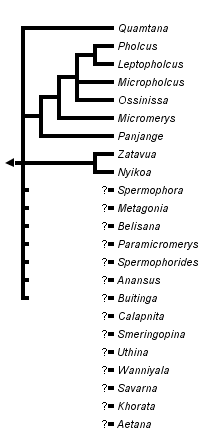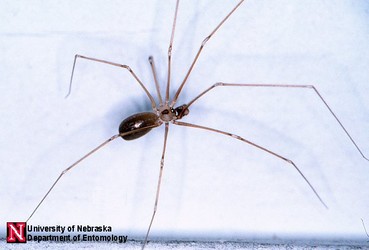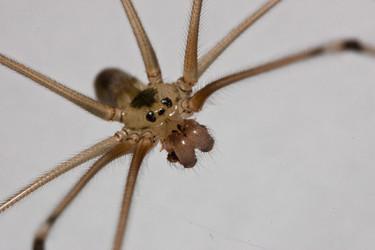Pholcines
Dimitar Dimitrov


This tree diagram shows the relationships between several groups of organisms.
The root of the current tree connects the organisms featured in this tree to their containing group and the rest of the Tree of Life. The basal branching point in the tree represents the ancestor of the other groups in the tree. This ancestor diversified over time into several descendent subgroups, which are represented as internal nodes and terminal taxa to the right.

You can click on the root to travel down the Tree of Life all the way to the root of all Life, and you can click on the names of descendent subgroups to travel up the Tree of Life all the way to individual species.
For more information on ToL tree formatting, please see Interpreting the Tree or Classification. To learn more about phylogenetic trees, please visit our Phylogenetic Biology pages.
close boxIntroduction
Most of the pholcines genera have an Old World distribution. A notorious exception is the genus Metagonia, a New World genus which was found to be more closely related to the pholcines genera than to the genera in the New World clade. Many pholcines species live in man-made structures, and common synanthropic species such as Pholcus phalangioides or Pholcus opilionoides are probably well known to everyone, however, pholcines is a very species-rich group with representatives living in a wide variety of habitats.
Characteristics
The presence of a pedipalpal trochanteral apophysis and a lateral cheliceral apophysis, which interact and provide a locking mechanism for the rotated pedipalp during copulation in Pholcus and several other pholcid genera, was used by Huber (1995) to define a group of pholcids which he named “Pholcus group”. Pholcines or Pholcus group was used ever since to refer to this group of genera.
In addition to the pedipalpal locking mechanism mentioned above, phylogenetic studies have found several other pholcine synapomorphies. These are: the presence of grooves on the cheliceral hairs, the tubular and membranous embolus, and the embolus spine (Huber, 2000).
Discussion of Phylogenetic Relationships
The tree used to represent the current phylogenetic hypothesis for pholcines summarizes the results of various phylogenetic studies using molecular and morphological characters (Bruvo-Madaric et al., 2005; Huber, 2000, 2001, 2005; Dimitrov and Ribera, 2005). None of these analyses has challenged the monophyly of pholcines, but internal relationships are still largely unresolved. Although Metagonia and Spermophora have the synapomorphies of the group and always appear to be closely related to the rest of pholcines genera, the question about their exact phylogenetic placement remains open.
References
Bruvo-Madaric B., Huber B.A., Steinacher A., Pass G. 2005. Phylogeny of pholcid spiders (Araneae:Pholcidae): combined analysis using morphology and molecules. Molecular Phylogenetics and Evolution 37: 661-673.
Dimitrov D., Ribera C. 2005. Description of Ossinissa, a new pholcid genus from the Canary Islands (Araneae: Pholcidae). ZOOTAXA 982: 1-13.
Huber B.A. 1995. Copulatory mechanism in Holocnemus pluchei and Pholcus opilionoides, with notes on male cheliceral apophyses and stridulatory organs in Pholcidae (Araneae). Acta Zoologica, Stockholm 76(4): 291-300.
Huber B.A. 2000. New World pholcid spiders (Araneae: Pholcidae): a revision at generic level. Bull. Amer. Mus. Nat. Hist. 254: 1–348.
Huber B.A. 2001. The pholcids of Australia (Araneae; Pholcidae): taxonomy, biogeography, and relationships. Bulletin of the American Museum of Natural History 260: 1-144.
Huber B.A. 2005. High species diversity, male-female coevolution, and metaphyly in Southeast Asian pholcid spiders: the case of Belisana Thorell 1898 (Araneae, Pholcidae). Zoologica 155: 1-126.
Huber B.A. 2007. Two new genera of small, six-eyed pholcid spiders from West Africa, and first record of Spermophorides for mainland Africa (Araneae: Pholcidae). Zootaxa 1635: 23-43.
Title Illustrations

| Scientific Name | Pholcus phalangioides |
|---|---|
| Comments | Long-bodied cellar spider |
| Source | University of Nebraska-Lincoln Entomology: Common Spiders |
| Copyright |
© Jim Kalisch

|
| Scientific Name | Pholcus phalangioides |
|---|---|
| Specimen Condition | Live Specimen |
| Source | Longbodied Close-up |
| Source Collection | Flickr |
| Image Use |
 This media file is licensed under the Creative Commons Attribution-NonCommercial License - Version 2.0. This media file is licensed under the Creative Commons Attribution-NonCommercial License - Version 2.0.
|
| Copyright | © 2008 Eric Heupel |
About This Page
Dimitar Dimitrov

Zoological Museum, University of Copenhagen
Correspondence regarding this page should be directed to Dimitar Dimitrov at
Page copyright © 2009 Dimitar Dimitrov
 Page: Tree of Life
Pholcines.
Authored by
Dimitar Dimitrov.
The TEXT of this page is licensed under the
Creative Commons Attribution-NonCommercial License - Version 3.0. Note that images and other media
featured on this page are each governed by their own license, and they may or may not be available
for reuse. Click on an image or a media link to access the media data window, which provides the
relevant licensing information. For the general terms and conditions of ToL material reuse and
redistribution, please see the Tree of Life Copyright
Policies.
Page: Tree of Life
Pholcines.
Authored by
Dimitar Dimitrov.
The TEXT of this page is licensed under the
Creative Commons Attribution-NonCommercial License - Version 3.0. Note that images and other media
featured on this page are each governed by their own license, and they may or may not be available
for reuse. Click on an image or a media link to access the media data window, which provides the
relevant licensing information. For the general terms and conditions of ToL material reuse and
redistribution, please see the Tree of Life Copyright
Policies.
- First online 12 February 2009
- Content changed 12 February 2009
Citing this page:
Dimitrov, Dimitar. 2009. Pholcines. Version 12 February 2009 (under construction). http://tolweb.org/Pholcines/135172/2009.02.12 in The Tree of Life Web Project, http://tolweb.org/









 Go to quick links
Go to quick search
Go to navigation for this section of the ToL site
Go to detailed links for the ToL site
Go to quick links
Go to quick search
Go to navigation for this section of the ToL site
Go to detailed links for the ToL site